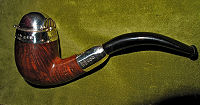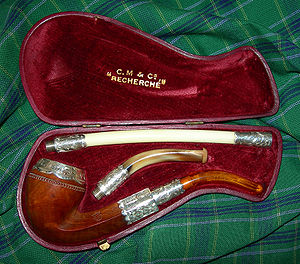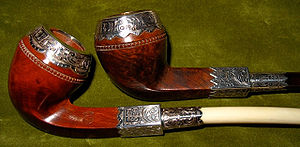Barling
This article needs extensive work. Our hope is that Barling experts will contribute and oversee the development of this important article. Barlings collectors, please dive in, or E-mail me if you have expertise and simply need help getting it in here: mailto:sethilepipes@gmail.com
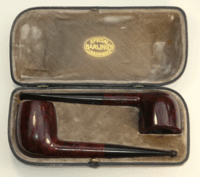
The Company
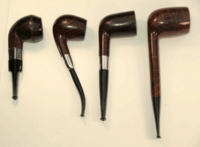
Barling is a great name in pipes among smokers and collectors alike. The original Barlings were silversmiths in England during the latter part of the 1700's, with their silver mountings first appearing on pipes in 1812. The company entered a "modern" phase in 1851 when they began carving pipes out of briar. Over the next 109 years the company gained an enviable reputation for the excellent smoking characteristics of their pipes, in addition to their unique interpretation of classic shapes, and the development of some "new" classics.
According to Richard Carleton Hacker, the company was sold by the Barling family in 1960 to the Imperial Tobacco Company. Barling expert, Tad Gage indicates in his often sited Pipes and Tobacco Magazine article (spring 2000 issue) that the date was 1962. After a brief transition period, the quality and identity of these fine pipes went down hill rapidly.
The periods

Barling has gone through three distinct periods, which dramatically effect collectability of the pipes. These are referred to as the Pre-transition, Transition, and Post Transition periods. The "pre-transition" pipes are highly sought after by collectors and have excellent smoking and aesthetic qualities. These pipes are famous for the "old wood" from which they were made. Many of the "transition" pipes were made from pre-transition bowls, and by the same craftsman. Therefore, many of the early transition pieces possess the same excellent qualities as the pre-transition pieces, yet they are not easily identified from later transition and post transition pieces, which were plagued by inferior materials and craftsmanship. While the transition pieces are not prized by collectors, some consider the early transition pieces an excellent value. The late transition, and post transition pipes have had a rocky road at best.
The literature is inconclusive on the exact dates of these periods. But the following is an attempt at reconciling the data:
Pre-Transition
The Pre-Transition period extends to 1960 (Hacker) or 1962 (Gage). The Barling family controlled production up till this point. Quality was excellent. Some sources indicate a marked inconsistency in quality starting as early as 1950.
Pre- Trans Nomenclature

Pre-transition nomenclature includes BARLINGS MAKE in block lettering, three digit shape numbers, and sizes noted with M, L, EL, EXEL, EXEXEL, and G. According to Tad Gage, the only four-digit number that denotes a Pre-Transition piece begins with "1," which was used for pipes sold in England. Any other four-digit Barling pipe is a transitional piece-- (Tad Gage in P & T magazine). Note: Pre-transition Guinea Grain pipes had Barling's Make in script, but experts indicate all other pieces with Barling's Make in script would be transition or post transition.
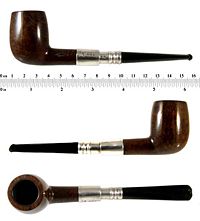
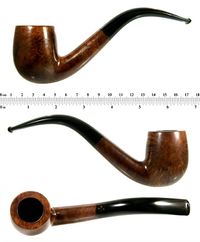
According to Tad Gage, Pre-1946 stampings were minimal. No size, shape numbers, or even grading appear on most pipes before World War II. Some shape numbers appear on certain pipes, but these markings are difficult to decipher. Most Barlings from this period were distributed to pipe shops and department stores in the British Isles, and often carried the shop's name. It is common to find only a small "BARLINGS MAKE" stamped in block capital letters, with BARLINGS over MAKE. Many of the older pipes feature sterling silver fitments, which make dating a simple mater of looking up London hallmarks, and the "EB WB" Barlings guild stamps. Some transition pieces utilized the same smaller block lettering stamps, but other nomenclature will be a tip off (such as the 4 digit date code starting with anything other than a "1").
Few if any Barling pipes were made during the war. From 1946 to 1962 Barlings will most often have the three digit shape numbers, and sizes as indicated above, although some did not have shape numbers. In particular, the Quaints and straight grains. This is the period Barling started exporting to the US.
Transition
The early transitional Phase is considered to be 1962-1964, the first two years after the Barling family sold the company (Hacker indicates the transition started in 1960). Some indicate a "lessoning" of the standards that pre-dates the actual change of ownership. The changes in nomenclature are difficult to follow, however, and regardless, while perhaps excellent smokers, early transition pipes are far less valuable to collectors than pre-transition.
Initially, the transition company used the remaining stock of bowls that were turned by the original family run company, and then proceeded to turn more bowls with old wood remaining in inventory, and at least initially, this work was performed by many of the same craftsman. Some consider the transition pipes to be an excellent value, while later transition pieces are nearly valueless, making it an exciting gamble for those so inclined!
The late Transitional Phase is considered to be 1962-1967. Speculation being that very little if any older wood remained in the factory after 1964. Most, if not all of the craftsman working under the Barling family had also have left by this time.
Transition Nomenclature
Right after the sale a new numbering system was put in place using four digits instead of the previous three digits. The first digit indicates size, and the next three represent the shape number. So for example 3374, 4374, and 5374 were all the same shape, just three different sizes. Sizes started at "2" and went up to "6" followed by King. This loosely followed the old M, L, EL, EXEL, EXEXEL, G sizing system.
You will occasionally find a pipe that has two shape numbers, an obvious pre-transition number (and corresponding pre-transition nomenclature, such as block BARLINGS MAKE lettering) as well as a post-trans 4-digit shape number. These are likely pre-transition pieces that were completed and in the inventory of Barling when the company was sold to the transition company and re-stamped by them.
For a short while, the transition company apparently used the small BARLING'S MAKE stamp (commonly used before the war), along with their new four digit shape numbers. So one might mistake this for a pre-transition piece, and they were likely made from the same old stock of briar. It's difficult to know if a pipe marked this way was made by the pre-transition company and finished by the transition company, or if they are transition made pipes.
In addition to the four digit shape numbers, the transition company switched over to a "Barlings" in script for the shank nomenclature (instead of the block "BARLING'S arched over "MAKE".) With the exception of the Guiena Grain pipes, these pipes are all either transition, or post transition pipes.
To further complicate matters, Barling used to sell their pipes to various shops, and would stamp the shop's name on the pipe. These were older pieces, from the 1950's or earlier. One shop in particular, JJ Fox is believed to have stamped their own shape numbers on the pipe.
Other changes in nomenclature made by the transition company include dropping the "EXEL" size indication (as this was redundant now), and the period in "MADE IN ENGLAND." was also dropped. "YE OLDE WOOD" was also removed (at least for a time).
A complicating factor is that over the next few years, nomenclature changed back and forth. T.V.F. was removed and put back as well as YE OLDE WOOD. At some point either the transition or post-transition company also returned to using the EXEL, EL, size stamps, along with the new numbering system.
Conclusion: The early transition pipes are considered good pipes. Most were made from old-stock briar. They are also good values on the estate market, although the early transitions, marked with the small "BARLING'S MAKE", are starting to get more expensive. The difficulty is determining in which part of the transition period any given pipe was made.
Post Transition
The Post Transition is from 1968 onward, but as far as most collectors are concerned, the interesting pipes from the transition period likely ended in 1964. Most if not all of the older wood was used up by this time. Post-transition pipes are not considered to be of near the quality of the transition pipes, let alone the pre-transition pipes.
Post Transition Nomenclature
Unfortunately there are many similarities between transition and so-called "Post-transition" nomenclature, so the question becomes, how to tell the difference?
Most transition pieces will have "Barlings" in script, and the 4 digit shape number. However, so will most post-transition pieces. In light of this, most collectors work from a process of elimination. Here are some factors to be considered:
- Anything that is "a line", such as "Regency", "Vintage", "Londoner", etc.. are post transition.
- Molded stems are post-transition.
- Handcut stems are transition.
- Poor grain and fills are post trans.
- Made In Denmark stamps are post transition.
- Small "BARLING'S MAKE" in block lettering that is arched, with a 4 digit number is likely transition, or possibly a pre-transition if other factors are in place.
- The "Barling"-style saddle stem and button are transition.
- Pipes stampled MADE IN ENGLAND are transition.
If a non-pre-transition Barling has the Barlings in a script, a 4-digit shape number, good grain with some pitting and good workmanship, and a typically-styled handcut Barling saddle bit, you can be reasonably certain is a transition pipe.
Sources
- Rare Smoke, Volume 1, by Richard Carleton Hacker
- Pipe.org discussion [3]
- Several A.S.P posts Micheal Lindner[4], Mel Feldman[5], and others.
- Tad Gage article, Mysterious Barlings, pg.40, Spring 2000 edition of Pipes & Tobacco Magazine.
- Mel Feldman's site: http://thesmoker.com/ generally has a lot of Barlings, with good indications of the nomenclature as it relates to period of manufacture. It was also mentioned that Mel is writing a book on Barlings. Mel's contact information is: The Smoker, P.O. Box # 3036, Albany, NY 12203; Phone:(518) 462-1302 (Mon-Fri. 9:00am - 5:00pm). E-mail: mailto:pipes@thesmoker.com
Sources to check
- "A smoker's guide to Barling" by Tad Gage in "Pipe Friendly" vol. 1, # 3 pp. 7, 1995.
